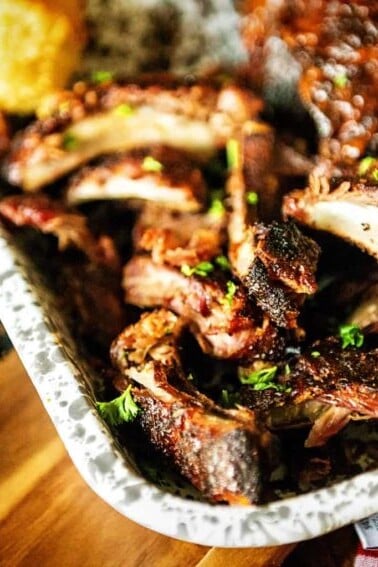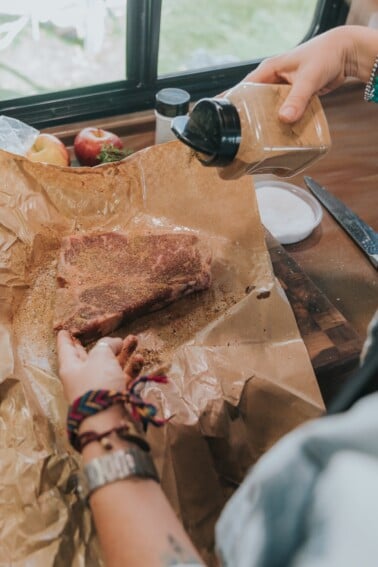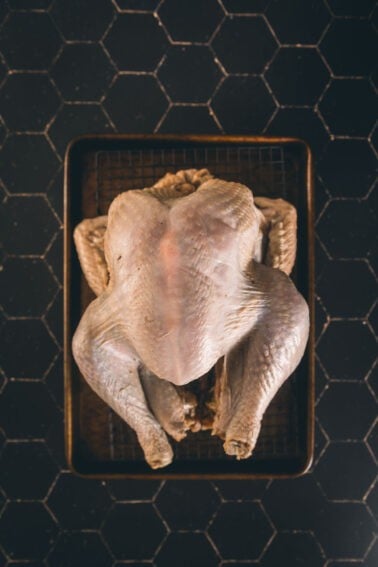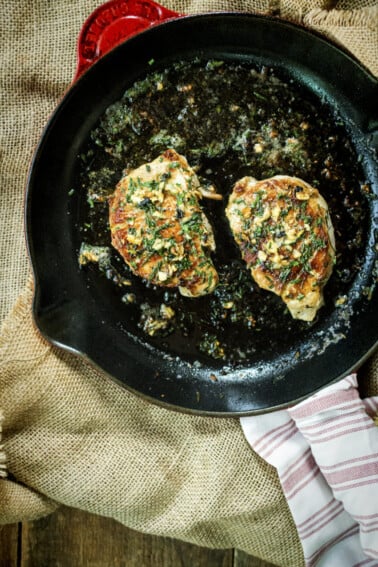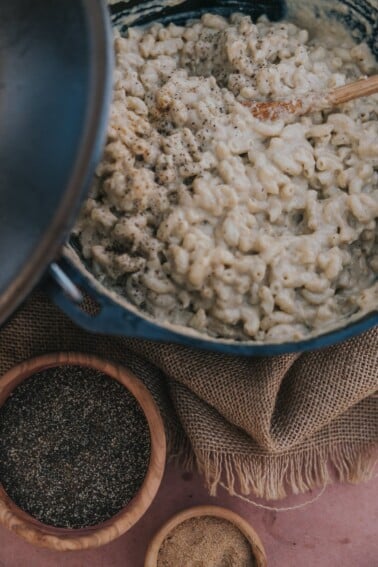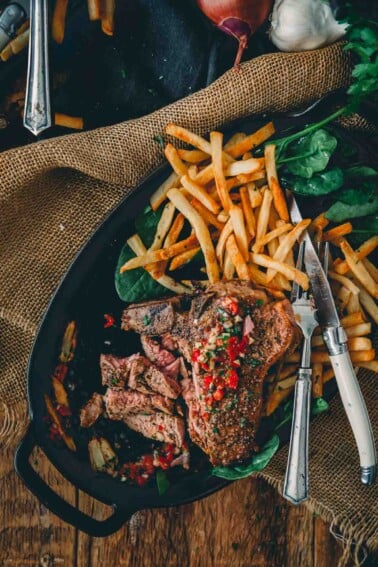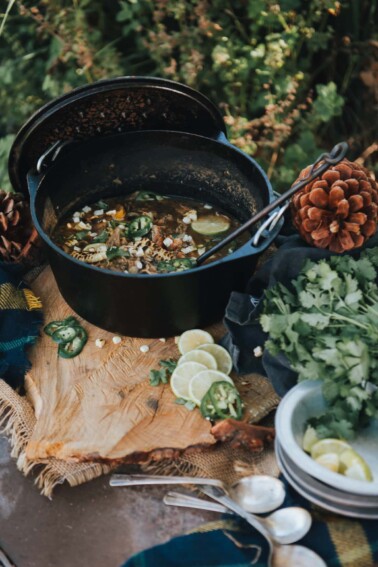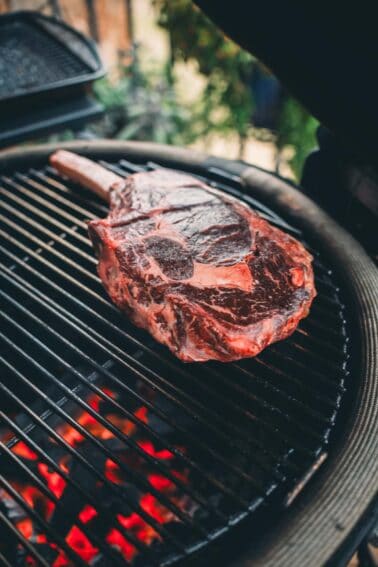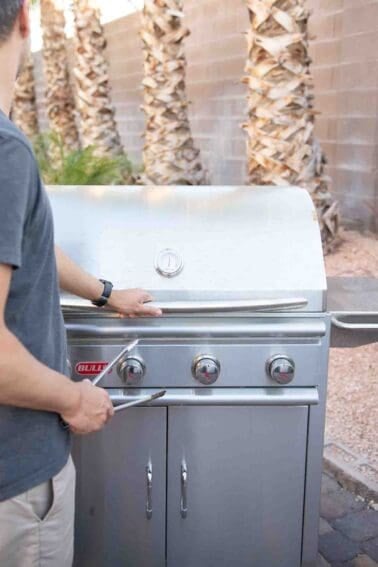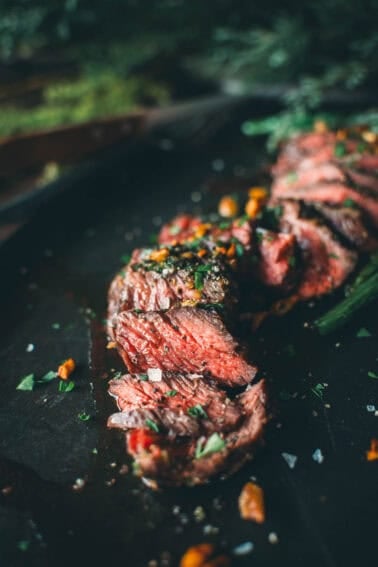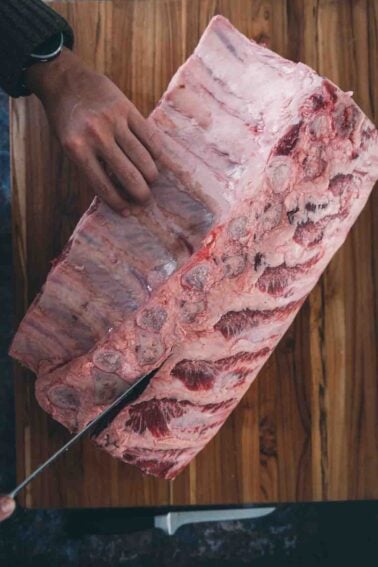Seasoning a cast iron pan is the key to unlocking its full potential in the kitchen. With a well-seasoned pan, you can enjoy the benefits of natural non-stick cooking, exceptional heat retention, and even enhanced flavor in your dishes. Follow our guide to understanding why and how to season your cast iron and elevate your cooking experience.

Table of Contents
- TL;DR Quick Tips for Seasoning Cast Iron
- What is a seasoned cast iron skillet?
- Why Cast Iron Skillets need to be Seasoned
- What You’ll need to Season
- How to Season Cast Iron
- Quick Steps for Seasoning Cast Iron
- Maintaining Your Cast Iron
- Helpful FAQs
- Best Pan-Seared Steaks in cast iron
- Our Favorite Cast Iron Skillet Recipes
- How to Season a Cast Iron Skillet Recipe
TL;DR Quick Tips for Seasoning Cast Iron
- Seasoning a cast iron skillet is essential for enhancing non-stick properties, heat retention, and durability.
- The seasoning process involves coating the skillet with oil and heating it to create a protective layer.
- Benefits of a well-seasoned skillet include enhanced flavors in dishes, even heat distribution, and rust prevention.
- Regular maintenance such as cleaning cast iron, drying, and oil application is required, but the result is a versatile, long-lasting kitchen tool.
- This guide provides an easy step-by-step process for seasoning your skillet and tips for maintaining it.
If you didn’t grow up with a Southern grandmother, cooking over a campfire, or are just getting used to cooking, using cast iron is intimidating. The pans are heavy, hot, and if you don’t know how to care for them, they can rust easily.
But, a good cast iron pan is a tool we swear by in the GirlCarnivore Meat Labs and is our go-to cooking tool for getting the perfect pan-sear on steaks to slow braising authentic beef birria in my Dutch oven. Cast iron is naturally non-stick and holds heat evenly, making it one of the most affordable and versatile pans any cook can own. Whether we’re cooking over live fire at or on the range, cast iron is always our choice.
A cast iron skillet is a kitchen essential that can last for generations with the right care and maintenance. One of the most important steps in caring for your cast iron skillet is seasoning it properly. Seasoning not only helps create a non-stick surface, but it also protects the skillet from rust and ensures even heating. In this article, we will guide you through the steps to season your cast iron skillet to perfection, so you can enjoy cooking with it for years to come.
What is a seasoned cast iron skillet?
To “season” cast iron refers to the process of creating a protective layer on the surface of the cookware to enhance its non-stick properties, prevent rusting, and improve its overall performance. It involves coating the cast iron with a thin layer of oil or fat and heating it to a specific temperature, allowing the oil to polymerize and form a natural non-stick coating. Seasoning helps to develop a smooth, black patina on the cast iron cookware, which improves its durability and makes it more resistant to sticking when cooking.
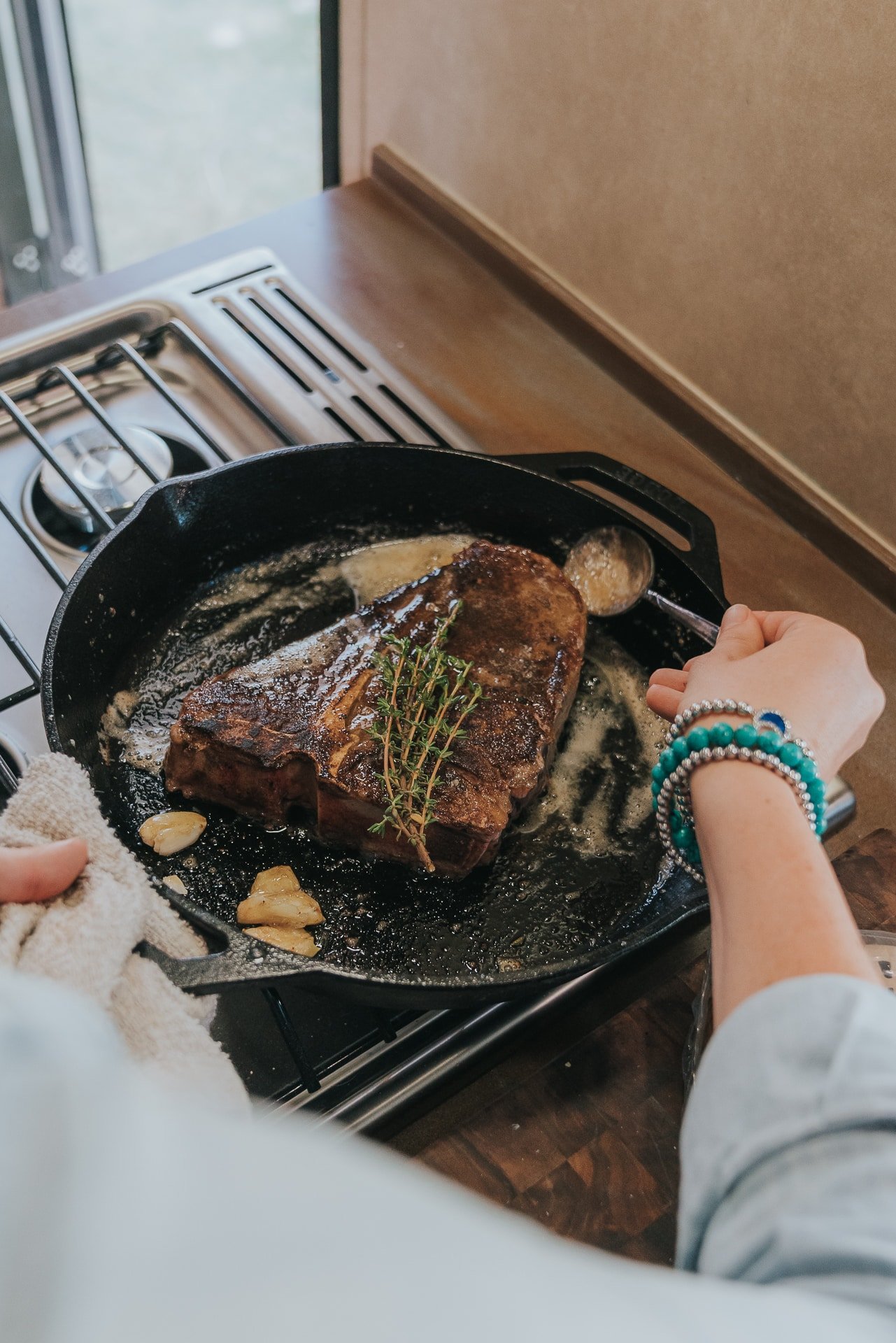
Why Cast Iron Skillets need to be Seasoned
Cast iron needs to be seasoned to create a protective layer on its surface. Seasoning involves applying oil and heating it to a high temperature, which polymerizes the oil and forms a durable, non-stick coating. This protective coating helps prevent rust, enhances the non-stick properties of the skillet, and improves its overall performance and longevity.
Getting that edge to edge crust on a reverse seared steak? Crispy chicken skin on pan seared chicken thighs? You can thank your well seasoned cast iron for that.
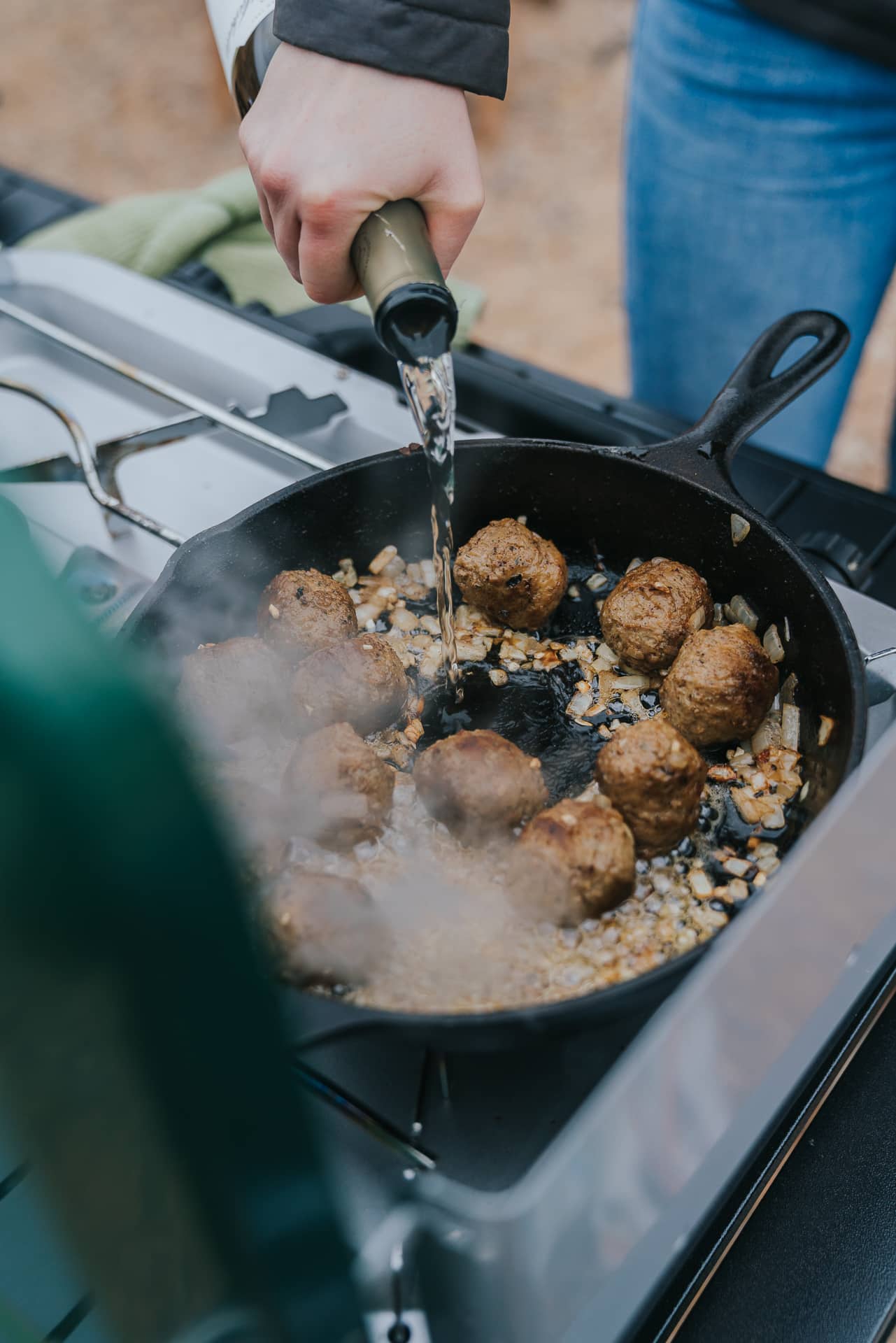
Advantages of a well-seasoned Cast Iron Skillet
Caring for a cast iron skillet isn’t like looking after other cookware. First, you must work with it a little and build a nice seasoning. Even so, the process is straightforward, and once you get the perfect finish, it’s undoubtedly worth the effort. The term seasoning means more than flavorful spices. In lay terms, seasoning refers to baking a thin layer of oil into the pan.
More technically, this process is called polymerization, which happens by heating an oil past its smoking point, thereby carbonizing it and effectively bonding the carbonized oil to the pan. This bond fills the otherwise porous surface and leaves you with a slick cooking surface.
The Benefits of a Well-Seasoned Pan Include:
- Non-Stick Surface: Cast iron’s signature dark black sheen, called patina, is largely thanks to the seasoning. Seasoning creates a natural, non-stick coating on the skillet’s surface. This allows you to cook with less oil and makes cleaning easier.
- Longevity: Cast iron is prone to rusting when exposed to moisture. Seasoning forms a protective barrier that shields the skillet from moisture and oxidation, preventing rust.
- Enhances Flavor: The oils used for seasoning can infuse your dishes with added flavors over time, enhancing the taste of your food.
- Heat Retention and Distribution: A well-seasoned cast iron skillet has excellent heat retention and can distribute heat more evenly. This results in better, more consistent cooking results.
- Durability: Regularly seasoning your skillet can prolong its lifespan, allowing it to remain a useful and beloved tool in your kitchen for many years.
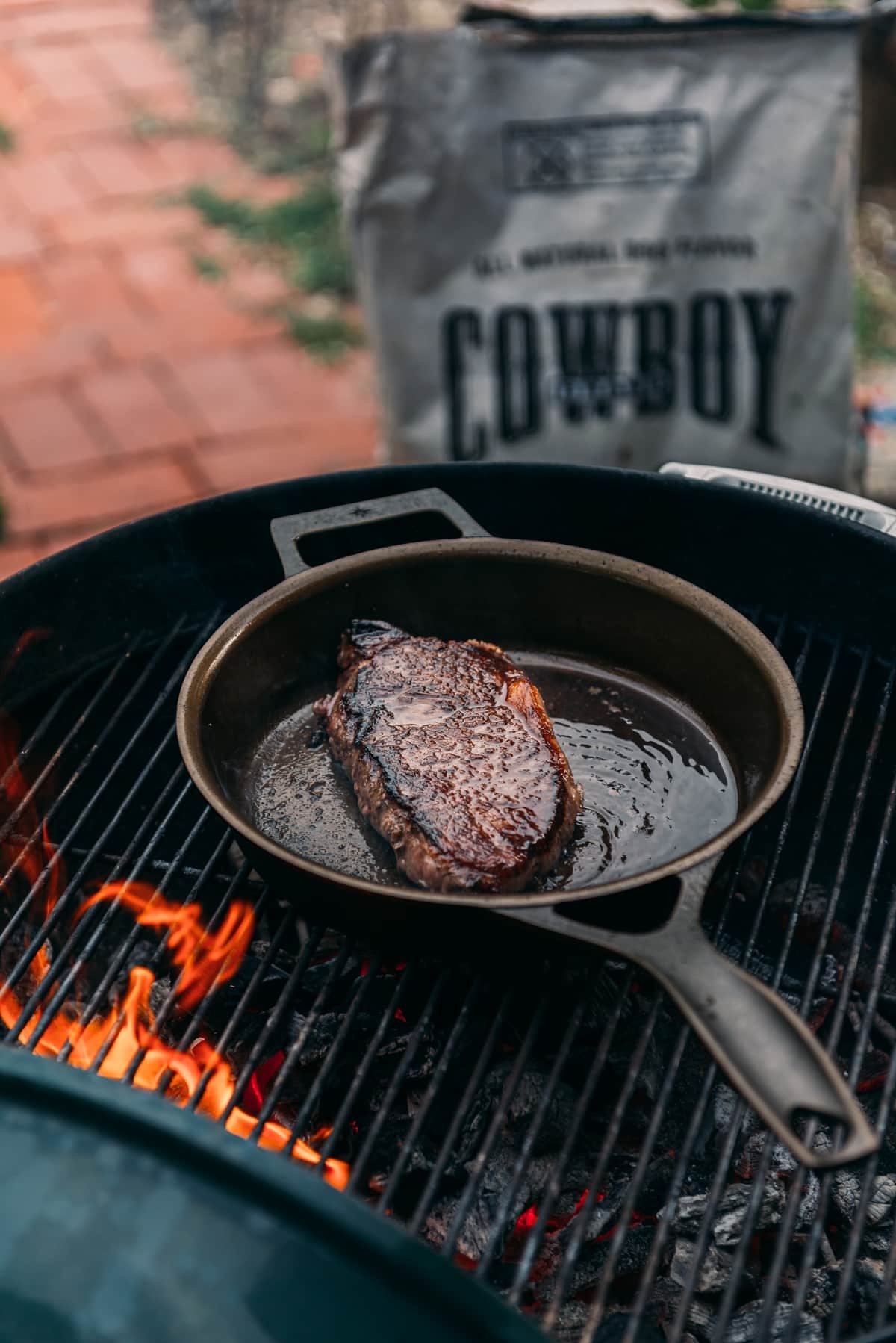
What You’ll need to Season
With a few basic tools, you’ll be seasoning in no time.
- Oil: Avoid butter and unrefined coconut oil. Otherwise, pick your favorite with a neutral flavor. Some prefer plant sources like flaxseed or vegetable oil, while others opt for rendered tallow or lard.
- Paper towels: Spread the oil around with a folded paper towel. Rub thoroughly over both the inside and outside of the pan.
- Oven mitts or heat resistant gloves: Protect your hands with oven mitts while handling a hot skillet.
- Baking sheet: Place a sheet under the skillet while it bakes in the oven and catch any excess oil that drips off.
Best Oil for Cast Iron
Use a neutral oil like vegetable oil, tallow or lard for the best results.
Can you season cast iron with olive oil?
We occasionally wipe our skillets down with olive oil, but when we’re doing the work to season them we use vegetable oil.
Can you season cast iron with coconut oil?
Technically you can use any oil to season a cast iron skillet.
Can you use vegetable oil to season cast iron?
Yes, Vegetable oil is our go to choice when seasoning.
How to Season Cast Iron
Sometimes the welcome benefits of cast iron cooking aren’t enough to dispel the misconception that the seasoning process is complicated, time-consuming and difficult.
The truth is that you can get great results in a few simple steps. Call it lazy, simple, or just plain practical, but you don’t need to spend hours scrubbing and applying layer after layer of oil every time you use the pan.
The basic approach starts with a clean pan, adds an even layer of oil, heats the two together and finally lets the pan cool down naturally.
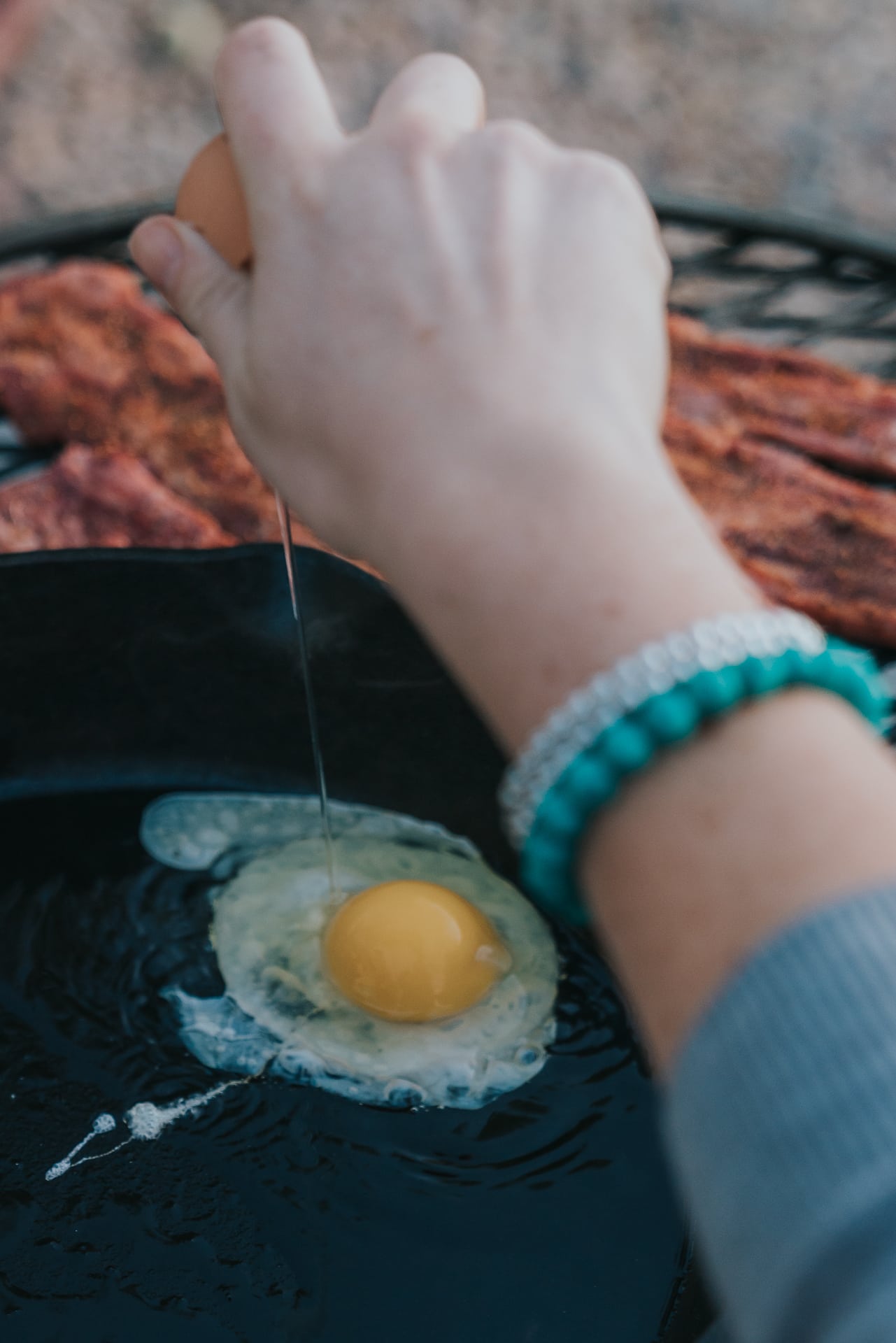
Quick Steps for Seasoning Cast Iron
Here’s our step-by-step guide to seasoning a cast iron skillet. This is a comprehensive process designed for maximum effect.
- Clean: Always start with a clean skillet. For stubborn stuck-on food, a paste of coarse kosher salt and water can be used as a gentle scrub.
- Dry: Dry the skillet completely. Wipe it dry with a kitchen towel, then heat it over medium heat on the stovetop until all the moisture evaporates.
- Oil: Pour one teaspoon of oil into the skillet and rub thoroughly all over with a folded paper towel. Carefully flip the pan over, add one teaspoon of oil on the underside and repeat the process, rubbing all over, including the handle. Continue buffing until the oiled pan no longer appears greasy.
- Bake: Preheat the oven to 450 F. Arrange a baking sheet on the center rack to catch any drips of oil that might come off. Place the skillet upside down and bake for 45 minutes to one hour.
- Cool: Turn off the oven and let the entire pan cool to room temperature. You can take the pan out if you need to or leave it to sit and cool inside the oven.
Seasoning Older Rusted Out Pans
Following these steps is particularly important if you’re working with an old pan or recently stripped the pan and are building up seasoning from scratch.
In that case, repeat steps two through five multiple times until you see a solid layer of protection. Michelle Price from Honest and Truly shares a helpful tip, reminding us not to feel rushed. She says, “Depending on how much time I have, I may do this over the course of a few days. You don’t have to do it immediately.” So, take your time and work when it is most convenient. Why not plan ahead and season the pan while the oven preheats before baking a family favorite like chicken Ranch casserole?
Maintaining Your Cast Iron
Ongoing maintenance is even easier once the foundational layer of seasoning sets. Here are some tips for cleaning your cast iron skillet so the seasoning lasts for months.
- Rinse and wipe the pan dry shortly after cooking. Heat over medium heat before storing so you know all water has evaporated off.
- Store in a dry place to avoid rust.
- Use wooden utensils and cast iron cleaning tools to avoid scratching the seasoning.
- Place a paper towel between cast iron when stacking, also to avoid scratching.
- Re-season with our step-by-step instructions anytime the skillet looks dull or food begins sticking to the bottom or sides.
Daily Maintenance for Cast Iron
- For day-to-day maintenance, we simply wipe out a well-seasoned cast iron pan with a towel when we’re done cooking, and it’s cooled. Then brush it with a light coat of oil after every three or four uses.
- Avoid long cooks with acidic foods, like tomato, citrus, and vinegar in your cast-iron skillet. The acidity in these foods can break down your layer of seasoning, causing food to stick and making the pan harder to clean. They also can get a tinny or metallic taste.
Helpful FAQs
It is recommended to season your cast iron skillet whenever the seasoning starts to wear off or after deep cleaning. As a general guideline, seasoning once every few months is usually sufficient for regular use.
A high-smoke-point oil such as vegetable oil, canola oil, or flaxseed oil works well for seasoning a cast iron skillet. Avoid using oils with low smoke points like olive oil.
Butter and margarine are not ideal for seasoning as they have low smoke points and can leave a sticky residue. Stick to oils with higher smoke points for the best results.
Generally, it is recommended to leave the cast iron skillet in the oven for about an hour while seasoning. This allows the oil to polymerize and create a durable seasoning layer.
It is recommended to apply multiple thin layers of seasoning for the best results. Three to four layers are usually sufficient, but some people prefer to apply more for a thicker coating.
While stovetop seasoning can be done, it is generally more effective to season a cast iron skillet in the oven. The oven temperature allows for more even heating and better polymerization of the oil.
Most new cast iron skillets come pre-seasoned, but it’s still a good idea to give them an additional layer of seasoning before use. This helps to enhance the non-stick properties and build up a stronger seasoning layer.
If your cast iron skillet develops rust, you can remove it by scrubbing the affected area with steel wool or a scrub brush and then re-seasoning the skillet. Regular use and proper drying after cleaning can help prevent rust.
It is generally recommended to avoid using soap on a seasoned cast iron skillet as it can strip away the seasoning. Instead, use hot water and a stiff brush or scraper to clean the skillet, and dry it thoroughly.
To maintain the seasoning on your cast iron skillet, avoid using harsh abrasive cleaners, and always dry it thoroughly after cleaning to prevent moisture-related issues. Additionally, applying a thin layer of oil after each use can help maintain the seasoning.
No. Absolutely not. In order to maintain the seasoning of your cast iron skillet, always wash it by hand and dry it immediately to prevent rust. Dishwashers detergents can strip away the seasoning and the excessive heat and moisture will cause your cast iron to rust.
Best Pan-Seared Steaks in cast iron
Recipes With Pork
How To Smoke Ribs
GC Original
What Is Umami? (and how to use it)
Poultry Recipes
Easy Way to Brine a Turkey + Best Turkey Brine!
There you have it. By following these simple tips, you can be a happy owner of a rust-free cast iron skillet with a beautiful nonstick surface. With a bit of care, your skillet can be a cherished kitchen tool for everything from the best beef and broccoli stir-fry to baking, searing, and pan-frying.
Our Favorite Cast Iron Skillet Recipes
Recipes With Pork
Pan Seared Pork Chops
Campfire Recipes
Dutch Oven Mac and Cheese
Seafood
Pan Seared Salmon
Campfire Recipes
Dutch Oven Shrimp Korma
Veal Recipes
Pan Seared Veal Chops
Campfire Recipes
Dutch Oven White Chicken Chili

Seasoning a cast iron skillet is an important process that ensures your cookware remains non-stick and protected from rust. The process is simple and can be done in just a few steps. Remember to clean your skillet properly before seasoning, use a high smoke point cooking oil, and place it upside down while baking in the oven. With proper care and maintenance, your cast iron skillet will last for generations to come, providing you with delicious meals and memories to cherish. So go ahead and give your trusty old skillet some TLC with these easy seasoning tips.
How to Season a Cast Iron Skillet
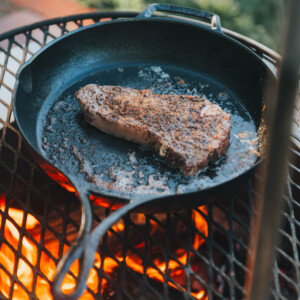
Recommended Equipment
Ingredients
- Oil high smoke point oil like flaxseed, grapeseed, canola or vegetable oil
- Paper towels
- Oven mitts or heat proof gloves
- Baking sheet
Instructions
Clean:
- Always start with a clean skillet. For stubborn stuck-on food, a paste of coarse kosher salt and water can be used as a gentle scrub.
Dry:
- Dry the skillet completely. Wipe it dry with a kitchen towel, then heat it over medium heat on the stovetop until all the moisture evaporates.
Oil:
- Pour one teaspoon of oil into the skillet and rub thoroughly all over with a folded paper towel.
- Carefully flip the pan over, add one teaspoon of oil on the underside and repeat the process, rubbing all over, including the handle.
- Continue buffing until the oiled pan no longer appears greasy.
Bake:
- Preheat the oven to 450 F.
- Arrange a baking sheet on the center rack to catch any drips of oil that might come off.
- Place the skillet upside down and bake for 45 minutes to one hour.
Cool:
- Turn off the oven and let the entire pan cool to room temperature.
- You can take the pan out if you need to or leave it to sit and cool inside the oven.
Notes
For day-to-day maintenance: Wipe out a well-seasoned cast iron pan with a towel when we’re done cooking, and it’s cooled. Then brush it with a light coat of oil after every three or four uses.
Avoid long cooks with acidic foods, like tomato, citrus, and vinegar in your cast-iron skillet. The acidity in these foods can break down your layer of seasoning, causing food to stick and making the pan harder to clean. They also can get a tinny or metallic taste.
Bookmark this recipe now!
Parts of this article were written by Jessica Haggard of Primal Edge Health. This article originally appeared on Food Drink Life.

